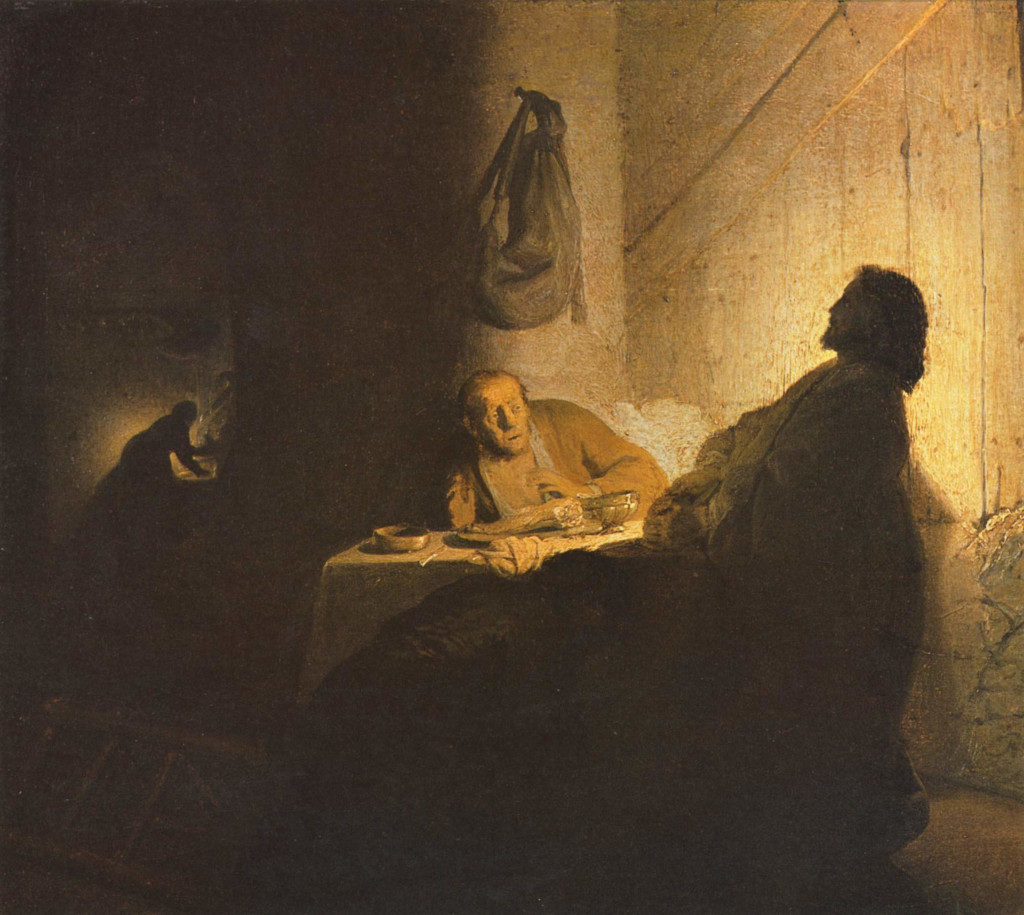The Rev. Noah Van Niel
April 26th, 2020
The Chapel of the Cross
Easter III: Acts 2:14a, 36-41; Psalm 116: 1-3, 10-17; 1 Peter 1:17-23; Luke 24: 13-35
To view video of the sermon click here.

My grandfather was a Professor of History at the University of Hawaii for many years. As a historian, he loved stories. Now I love my Grandpa, but when we would visit their home in Honolulu he would hold my brother and me hostage at the dinner table for hours after the last plate was cleared, telling, and retelling, stories from his life. I can still remember my legs affixing to the pleather seats in the sweet, humid Hawaiian air, longing to be released so I could go play on the lanai that overlooked the majesty of Diamondhead crater and out onto the Pacific Ocean. But alas, there was no escape until well after dark. Grandpa’s research specialty was Southeast Asia, particularly Indonesia, a country that had just gained its independence from Holland when he was beginning his work. My grandfather had served in the South Pacific in the Second World War, and his family had come to the States from Holland in the early 20th century so Indonesia was a perfect point of focus for him. He would tell us stories from both those countries and his time working and studying in each of them. Stories like how my father was born in a tiny Seventh Day Adventist hospital in Bandung while Grandpa was over there doing research for his dissertation. And stories about his colorful family in Holland, who, as new immigrants to America, made him dress up as a little Dutch boy to sell tulip bulbs in Cleveland, Ohio. The Netherlands remained a second home for my Grandfather throughout his life. He would return regularly for research, and a good portion of his time was spent in the small town of Leiden. Leiden is famous for two things: its world class University, and for being the hometown of 17th century artistic legend Rembrandt van Rijn. It was from Leiden that Rembrandt helped launch what became known as the Golden Age of Dutch painting. And there is a Rembrandt Museum around the corner from the University that my grandfather would frequent, kindling a lifelong love of the Dutch Masters. A love I have inherited.
Apart from their aesthetic abilities, one of the things I find so appealing about these Dutch Masters is their concentrated focus on everyday life. This was a major divergence from the almost exclusively religious subjects of the medieval period, and from the lifestyles of the rich and famous that constituted much of the art work of the Renaissance. But coinciding, as this Golden Age did, with the Age of Reformation in Europe, and the more egalitarian outlook it promoted, Rembrandt and his contemporaries intentionally took as their subjects the lives of peasants, farmers, and tradesmen. The average Jozef, you might say. They revered quotidian domesticity and honored it as a locus of beauty. They found the extraordinary in the ordinary. And in their hands, normal life, average life, simple life, boring life, became remarkable, revelatory, transcendent, thanks to a few deft brushstrokes, and inventive uses of color, shadow, and light.
As we have been listening to some of the Resurrection stories in our Sunday Gospel readings this Easter season, one of the most remarkable things that has struck me is actually how unremarkable they are. Jesus slips in to scenes of normal life and makes them shine, for a moment, with the glory of his presence, before slipping right back out again. If I had just trampled down death under my feet, I would want a bit more of a victory parade: trumpets, crowds, you know, a big show. But that’s not how Jesus goes about revealing himself. He’s casually in the garden as Mary comes to mourn. He sneaks in and out of locked that upper room with nary so much as a knock. He just appears on the seashore while the disciples are out fishing.
And today, he shows up on the Road to Emmaus. You know the story: two disciples are out on a walk and talk, trying to process all the tumultuous events of the last 72 hours. And as they go along a stranger sidles up to them and falls into step. A gentle inquiry gets him into the conversation, and he starts to connect the dots for them. As he talks, their confusion and grief begin to dissipate, so they ask him to stay for supper. It couldn’t have been much of a feast they were inviting him to. But there, around the table, in the ordinary act of taking, blessing, breaking, giving, their eyes are opened and for a moment they glimpse him, Jesus, the resurrected Christ, Emmanuel, God still with us. And then just like that he vanishes from their sight. He slips in, and slips out. Slips into our ordinary lives and makes them, for a moment, anything but.

Interestingly, Rembrandt painted two versions of this Emmaus story, and left us at least two hand drawn sketches as well. Even for an artist as prolific as he was, this denotes a certain fixation. Perhaps it was the intriguing mix of the ordinary and the extraordinary in this story that kept drawing him back to it. (If you’d like to look at these pieces up close, here is a link that will take you to a website where you can view them [https://www.artbible.info/art/large/342.html.) The settings for both paintings are humble—small tables, dank surroundings, simple meals, Rembrandt’s trademark use of extreme light and shadow. The first painting, from 1628, happens to be my favorite. Jesus is illuminated from behind as a silhouette, leaning back, almost as if he’s laughing. One disciple cowers in surprise, the other falls to his knees, disappearing into the shadows beneath the table. And in the other room we see a woman washing the dishes, completely oblivious to what’s happening right nearby. The second painting of this scene comes from 1648 and if the more famous of the two. It’s more refined than the 1628 version, but equally interesting. The disciples seem to be just starting to recognize who their mysterious companion is. One is raising his hands to his face—in delight or defense we can’t quite tell. The other is shifting in his seat, his gaze is transfixed on Jesus, seemingly asking, “Could it really be?” And meanwhile, a young man, their waiter, leans over the table with their food, clueless to what is happening right under his nose. How interesting, these attempts to capture this moment of recognition, of revelation, of Resurrection in the middle of mundanity. How interesting to see the mix of fear, awe and wonder in the bodies and eyes of the disciples who have had Jesus with them for hours, and didn’t even know it. And how interesting that both paintings include others who completely miss what is happening right before their very eyes.

I think sometimes we too miss the resurrected Christ right under our noses. If we’re lucky we might be like the disciples and catch a glimpse of him, but more often we are like the servants, completely oblivious to his presence. We miss him because we are looking in the wrong place for resurrection. We are looking for the flash and the bang and the “wow.” And while we’re looking for the Resurrected Christ to make a big to do about showing up, he’s sneaking in and out of our everyday lives, imbuing them, like a Dutch Master, with a touch of transcendence that goes unnoticed, unless we’re looking for it. Maybe this is good news for us as we are all confined to a life of very limited routine right now; days of enforced domesticity that can seem completely devoid of anything approximating Resurrection glory. If your life is feeling oppressively ordinary at present, with one day running into the next with no distinction between them, then perhaps it is good to be reminded that Christ shows up in the middle of mundanity before anywhere else. He knows it is in the drudgery of everyday existence that it’s hardest for resurrection to shine, so that’s where he comes first. After all, if the resurrection promises of peace and love and comfort are going to be with all our days, then they have to be with us all our days. So Christ appears not in triumph and great glory, but quietly; in the garden, on the path, at the table; because that is where we are most of the time, and if he wants to be with us, then that’s where we need him to be. The good news is that if we do our part, and open our eyes to the possibility of his presence with us, even in the ordinary and every day, then our normal life, our average life, our simple life, our boring life, can be transformed, can become remarkable, revelatory, transcendent. But if we blink, we might miss it.
It took us a while to organize a funeral for my grandfather when he died. He passed suddenly, collapsing in the art studio where he had been taking classes in etching as a late in life hobby. Who knows, maybe it was Rembrandt, whose etchings were prized even more than his paintings during his lifetime, that turned Grandpa onto it. But being in Hawaii with us on the east coast and my aunt and her family in Hong Kong, gathering everyone in Honolulu took some time, but eventually we organized a memorial service for his friends and family. The service was nice–music, readings, reflections. There were pictures of happy times throughout my grandfather’s life and a generous reception where his friends graciously shared their condolences. But I must confess, that’s not where Christ appeared for me that day. He didn’t come until later, after all the guests had left, and we had packed all the leftovers into our rental cars and drove back up the mountainside to that little house overlooking paradise. It was there, in that dingy old kitchen, around that tiny table from which I had so often longed to flee, when we dumped the canapes onto plates and squeezed around—some of us sitting in those same sticky chairs, some of us leaning against the ancient cabinets, all of us snacking, and telling and retelling those same old stories—it was there, where that peace, that love, that comfort that the Resurrected Christ comes bearing, slipped quietly into our hearts. We laughed a lot. We cried a little. And in the corner of that crowded kitchen, not in the big show of a memorial service, but in a simple place, a normal place, a boring place, it was there that our eyes were opened, and he appeared.
